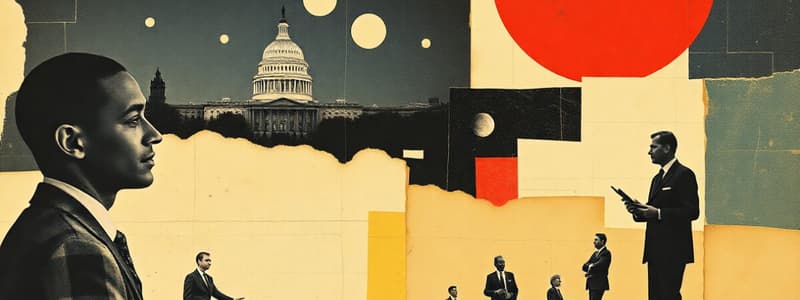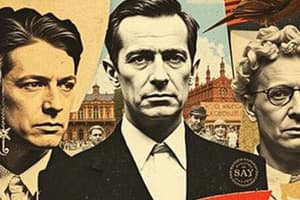Podcast
Questions and Answers
The book is divided into ______ parts.
The book is divided into ______ parts.
three
In the first part, the book focuses on ______ studies.
In the first part, the book focuses on ______ studies.
organizational
The second part delves into the concept of ______.
The second part delves into the concept of ______.
organization
The third part examines the different phases of ______.
The third part examines the different phases of ______.
The chapter on Mobilization discusses ______ to change.
The chapter on Mobilization discusses ______ to change.
The chapter on Leading Change emphasizes the importance of ______ roles.
The chapter on Leading Change emphasizes the importance of ______ roles.
The final chapter focuses on ______ change.
The final chapter focuses on ______ change.
The book concludes with a ______ and references.
The book concludes with a ______ and references.
During organizational change, a sense of ______ was common, as organizations adjusted to new processes and structures.
During organizational change, a sense of ______ was common, as organizations adjusted to new processes and structures.
______ was another prevalent emotion experienced during organizational change, reflecting feelings of uncertainty and confusion about the new direction.
______ was another prevalent emotion experienced during organizational change, reflecting feelings of uncertainty and confusion about the new direction.
The study by Worrall and Cooper found that over 90% of managers in all organizations were ______ by change.
The study by Worrall and Cooper found that over 90% of managers in all organizations were ______ by change.
The triad of cost reduction, use of contract staff, and culture change led to a decline in managers' ______ and morale.
The triad of cost reduction, use of contract staff, and culture change led to a decline in managers' ______ and morale.
Lewin's model of organizational change comprises three stages: unfreezing, ______ change, and refreezing.
Lewin's model of organizational change comprises three stages: unfreezing, ______ change, and refreezing.
Despite the challenges, organizations that successfully manage change show a marked sense of ______ and confidence.
Despite the challenges, organizations that successfully manage change show a marked sense of ______ and confidence.
In the context of organizational change, ______ refers to the process of preparing individuals and systems for the change.
In the context of organizational change, ______ refers to the process of preparing individuals and systems for the change.
The stage of refreezing in Lewin's model involves ______ the new processes and structures within the organization.
The stage of refreezing in Lewin's model involves ______ the new processes and structures within the organization.
Real leaders ask hard questions and knock people out of their ______ zones.
Real leaders ask hard questions and knock people out of their ______ zones.
There will inevitably be a number of ______ in the change who will have a view.
There will inevitably be a number of ______ in the change who will have a view.
Managing change successfully will need to take account of the voices and positions of these ______.
Managing change successfully will need to take account of the voices and positions of these ______.
The ______ movers of the change may include the CEO, project manager, or team leader.
The ______ movers of the change may include the CEO, project manager, or team leader.
How much they attend to the ______; how much they attend to the people is crucial.
How much they attend to the ______; how much they attend to the people is crucial.
The way stakeholders are engaged influences the emotional ______ of those affected.
The way stakeholders are engaged influences the emotional ______ of those affected.
Agents of change will need to negotiate their way through often competing and ______ needs.
Agents of change will need to negotiate their way through often competing and ______ needs.
Whether they’re autocratic or ______, all these styles impact the probability of achieving successful outcomes.
Whether they’re autocratic or ______, all these styles impact the probability of achieving successful outcomes.
An external analysis looks at the macro and micro factors that may impact on your organization and its performance in the short, medium and long term. Having done the initial analysis, you can generate a number of possible ______ that would suggest some of the scenarios.
An external analysis looks at the macro and micro factors that may impact on your organization and its performance in the short, medium and long term. Having done the initial analysis, you can generate a number of possible ______ that would suggest some of the scenarios.
Each of the factors that might impact your organization can be seen as a potential ______ or a potential opportunity.
Each of the factors that might impact your organization can be seen as a potential ______ or a potential opportunity.
To assess an organization’s current capabilities, we need to see whether it is fit for the ______ for which we want it to be.
To assess an organization’s current capabilities, we need to see whether it is fit for the ______ for which we want it to be.
One way to look at an organization's efficiency is to track and map the ______ chain and identify areas of misalignment.
One way to look at an organization's efficiency is to track and map the ______ chain and identify areas of misalignment.
The McKinsey 7S model represents the organization as a set of interconnected and interdependent ______.
The McKinsey 7S model represents the organization as a set of interconnected and interdependent ______.
The seven categories of the McKinsey 7S model include staff, skills, systems, style, shared values, strategy, and ______.
The seven categories of the McKinsey 7S model include staff, skills, systems, style, shared values, strategy, and ______.
The category that refers to the distinctive capabilities, knowledge, and experience of key people is ______.
The category that refers to the distinctive capabilities, knowledge, and experience of key people is ______.
The guiding ______ that make the organization what it is are referred to as shared values.
The guiding ______ that make the organization what it is are referred to as shared values.
The PESTLE analysis helps identify general external ______ that influence the organization’s ability to deliver.
The PESTLE analysis helps identify general external ______ that influence the organization’s ability to deliver.
Current and emerging trends in national and international ______ can significantly affect organizations.
Current and emerging trends in national and international ______ can significantly affect organizations.
Social trends such as changes in purchasing patterns and ______ influence market strategies.
Social trends such as changes in purchasing patterns and ______ influence market strategies.
Technological advancements create both challenges and ______ for organizations in the future.
Technological advancements create both challenges and ______ for organizations in the future.
Environmental crises, like climate change and potential oil ______, require organizations to adjust their strategies.
Environmental crises, like climate change and potential oil ______, require organizations to adjust their strategies.
Identifying key factors that enhance or ______ the organization’s strategy is crucial for planning.
Identifying key factors that enhance or ______ the organization’s strategy is crucial for planning.
Trends in individuals’ ______ can impact an organization's current and future offerings.
Trends in individuals’ ______ can impact an organization's current and future offerings.
In the PESTLE framework, the 'E' stands for ______, which considers the natural environment’s effects on business.
In the PESTLE framework, the 'E' stands for ______, which considers the natural environment’s effects on business.
Change can be classified between planned and ______.
Change can be classified between planned and ______.
Stace and Dunphy saw change on a ______ from minimal change to a fundamental shift.
Stace and Dunphy saw change on a ______ from minimal change to a fundamental shift.
The ______ was seen as a critical component when managing change.
The ______ was seen as a critical component when managing change.
On a team basis, the phenomenon of ______-think was highlighted.
On a team basis, the phenomenon of ______-think was highlighted.
The four types of change identified are adaptation, reconstruction, evolution, and ______.
The four types of change identified are adaptation, reconstruction, evolution, and ______.
The management researchers highlighted that complex changes are more likely to benefit from an ______ approach.
The management researchers highlighted that complex changes are more likely to benefit from an ______ approach.
The key framework for guiding organizational change includes orientation, mobilization, implementation, and ______.
The key framework for guiding organizational change includes orientation, mobilization, implementation, and ______.
To successfully orient a company towards change, one must first assess the need for ______.
To successfully orient a company towards change, one must first assess the need for ______.
Flashcards
Organizational Change Mood
Organizational Change Mood
The emotional state of an organization during changes, reflecting attitudes of employees.
Positive Outcomes of Change
Positive Outcomes of Change
Indicators such as focus, enthusiasm, hope, and confidence in organizations successfully managing change.
Negative Outcomes of Change
Negative Outcomes of Change
Common negative feelings during organizational changes including anxiety, confusion, and frustration.
Kurt Lewin's Change Model
Kurt Lewin's Change Model
Signup and view all the flashcards
Impact of Change on Managers
Impact of Change on Managers
Signup and view all the flashcards
Triad of Changes
Triad of Changes
Signup and view all the flashcards
Managerial Loyalty Decline
Managerial Loyalty Decline
Signup and view all the flashcards
Percentage Affected by Change
Percentage Affected by Change
Signup and view all the flashcards
Change Kaleidoscope
Change Kaleidoscope
Signup and view all the flashcards
7Ss Framework
7Ss Framework
Signup and view all the flashcards
Cultural Web
Cultural Web
Signup and view all the flashcards
Resistance to Change
Resistance to Change
Signup and view all the flashcards
Stakeholder Interests
Stakeholder Interests
Signup and view all the flashcards
Leadership Styles
Leadership Styles
Signup and view all the flashcards
Learning Organization
Learning Organization
Signup and view all the flashcards
Embedding Change
Embedding Change
Signup and view all the flashcards
Types of Change
Types of Change
Signup and view all the flashcards
Change Continuum Levels
Change Continuum Levels
Signup and view all the flashcards
Planned vs. Emergent Change
Planned vs. Emergent Change
Signup and view all the flashcards
Cultural Impact on Change
Cultural Impact on Change
Signup and view all the flashcards
Personality Types in Change
Personality Types in Change
Signup and view all the flashcards
Groupthink
Groupthink
Signup and view all the flashcards
Organizational Orientation to Change
Organizational Orientation to Change
Signup and view all the flashcards
Change Management Frameworks
Change Management Frameworks
Signup and view all the flashcards
Stakeholders
Stakeholders
Signup and view all the flashcards
Agents of Change
Agents of Change
Signup and view all the flashcards
Prime Movers
Prime Movers
Signup and view all the flashcards
Managing Distress
Managing Distress
Signup and view all the flashcards
Communication and Engagement
Communication and Engagement
Signup and view all the flashcards
Types of Leadership
Types of Leadership
Signup and view all the flashcards
Competing Needs
Competing Needs
Signup and view all the flashcards
Emotional Well-Being
Emotional Well-Being
Signup and view all the flashcards
External Analysis
External Analysis
Signup and view all the flashcards
Internal Analysis
Internal Analysis
Signup and view all the flashcards
Value Chain
Value Chain
Signup and view all the flashcards
Core Competences
Core Competences
Signup and view all the flashcards
McKinsey 7S Model
McKinsey 7S Model
Signup and view all the flashcards
7S - Staff
7S - Staff
Signup and view all the flashcards
7S - Skills
7S - Skills
Signup and view all the flashcards
7S - Shared Values
7S - Shared Values
Signup and view all the flashcards
PESTLE Analysis
PESTLE Analysis
Signup and view all the flashcards
Political Factors
Political Factors
Signup and view all the flashcards
Economic Trends
Economic Trends
Signup and view all the flashcards
Social Trends
Social Trends
Signup and view all the flashcards
Technological Advances
Technological Advances
Signup and view all the flashcards
Legal Requirements
Legal Requirements
Signup and view all the flashcards
Environmental Factors
Environmental Factors
Signup and view all the flashcards
Impact Assessment
Impact Assessment
Signup and view all the flashcards
Study Notes
Change Management Masterclass
- This book covers the complex subject of change management in a highly readable way.
- It's a step-by-step guide to successful change management by Dr Tim Hughes, Bristol Business School.
- Authored by Mike Green.
Praise for Change Management Masterclass
- Dr Tim Hughes, Bristol Business School, praised the book for its highly readable way of covering the complex subject.
- Chris Bones, principal of Henley Management College, called the book a thoroughly practical and straightforward change management handbook.
- Anjali Arya MBA, Organizational Development Consultant, described it as an excellent practical read.
- Philip Lawrence MBA, Programmes Manager, Alcatel Lucent, praised its structured navigation of change management.
- Deborah Bateman MBA, Manager, Business Support & Development, Halifax said the book is an excellent guide for both managers and students.
- Maria Jesus Fernandez-Gutierrez, Enterprise Core Voice Proposition Manager, Vodafone UK recommends it for its well-organized structure and case study approach.
- Pascoe Sawyers, Director, Leadership Academy, Improvement & Development Agency, highlighted the importance of adaptability and leadership capabilities for successful change.
- Bob Gorzynski, Centre for Strategic Thinking, noted the book's emphasis on highlighting robust models.
- Professor Colin Carnall, Director of Executive Programmes, Warwick Business School, University of Warwick, appreciated the book's practical approach, clarity of complex ideas and value to professionals and middle managers.
- Martin Broomfield MBA commended the book for the clear explanations of change dimensions and practical advice.
Contents
- Acknowledgements
- About the Author
- Introduction
- Part I: Approaching Change
- Introduction, metaphors and paradigms, types of change, culture, personality, and groupthink
- Part II: Orientation
- Introduction, the need for change, the change formula
- Part III: Organizational Case Studies
- Aster Group, the Institute of Public Health in Ireland, Biogen Idec, the British Council, County of Aarhus, Denmark, The Kitchenware Company, The Primary School, The Financial Services Company
- Mobilization
- Implementation
- Transition
- Leading Change
- Integration
- Conclusion
- Bibliography and references
- Index
Studying That Suits You
Use AI to generate personalized quizzes and flashcards to suit your learning preferences.




